Discover lush vegetation and enjoy the gentle kindness of the Zimbabwean people - a true intimate experience awaits you here in the heart of Africa. Venture through Zimbabwe’s most famous national parks such as Hwange, Lake Kariba, Mana Pools, and Matobo National Park during the day, and be spoilt by the truly African hospitality at night.
Departs: Bulawayo, Zimbabwe.
Ends: Victoria Falls, Zimbabwe.
Group size: Guaranteed from 4 guests; 12 guests maximum. *Guaranteed departures with no minimum pax available, please enquire.
Summary
A small-group lodge safari, from / to Victoria Falls through Zimbabwe.
Highlights
Matobo National Park and Rhodes Grave, Great Zimbabwe, Mana Pools, Lake Kariba and Matusadona National Park, Antelope Park, Painted Dogs Conservation Centre, Hwange National Park, Victoria Falls.
Meals
12x Breakfast, 11x Lunch, 11x Dinner. Where included most breakfasts and dinners will be enjoyed in the restaurants of the various accommodation establishments, however on certain nights the guide will provide an authentic meal for the group, which will be enjoyed together in the evening, often around a camp fire. Please advise us of any special dietary requirements in advance.
SAFARI
COST: $4,590 per person sharing, plus local payment of $250 (in cash).
SINGLE SUPPLEMENT: $1,585 |
CLICK TO SEE DEPARTURE DATES
|
|
DAY 1;
(1 Night)
MATOBO HILLS, Zimbabwe [Chalets] |
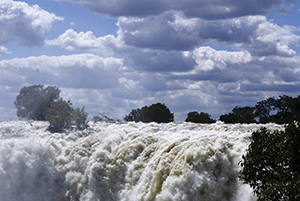 On arrival at Bulawayo Airport, you will be met and transferred to your lodge, Camp Amalinda, set in the majestic Matobo Hills area. The afternoon may be spent at leisure enjoying the panoramic views of the granite kopjes or participating in some optional activities. This evening you will meet your guide and the rest of your group at the lodge at 18h00 for your pre-departure meeting. On arrival at Bulawayo Airport, you will be met and transferred to your lodge, Camp Amalinda, set in the majestic Matobo Hills area. The afternoon may be spent at leisure enjoying the panoramic views of the granite kopjes or participating in some optional activities. This evening you will meet your guide and the rest of your group at the lodge at 18h00 for your pre-departure meeting.
|
Distance / Time: N/A
Overnight: Camp Amalinda or similar (rooms with en-suite bathrooms, restaurant, bar, & swimming pool).
Meals: Lunch for your own account; Dinner at Camp Amalinda or similar.
|
DAY 2;
(1 Night)
NATOBO NATIONAL PARK, Zimbabwe [Chalets] |
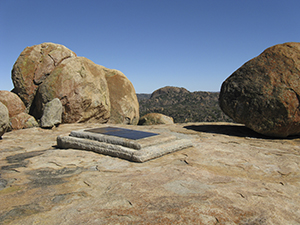 Matobo Hills is an area of exquisite beauty, steeped in tribal history, ancient mystery and dramatic rock landscapes. The national park has been given UNESCO World Heritage status and is home to both white and black rhinoceros, sable antelope and the world’s densest population of leopard. Birdlife is prolific and includes the highest concentration of black eagles in the world. Once the home of the San (Bushman), this area contains the richest source of the rock art found anywhere. Not only is it here that the Ndebele people buried their great king, Mzilikazi, but Cecil John Rhodes was also laid to rest on the “Hill of the Benevolent Spirit” or “World’s View” as named by him. We spend the day in the national park, starting our morning with tracking rhino spoor by vehicle and foot. In the afternoon we further explore the scenery and wildlife of the park on game drives, ending with a visit to Rhodes’ grave. Matobo Hills is an area of exquisite beauty, steeped in tribal history, ancient mystery and dramatic rock landscapes. The national park has been given UNESCO World Heritage status and is home to both white and black rhinoceros, sable antelope and the world’s densest population of leopard. Birdlife is prolific and includes the highest concentration of black eagles in the world. Once the home of the San (Bushman), this area contains the richest source of the rock art found anywhere. Not only is it here that the Ndebele people buried their great king, Mzilikazi, but Cecil John Rhodes was also laid to rest on the “Hill of the Benevolent Spirit” or “World’s View” as named by him. We spend the day in the national park, starting our morning with tracking rhino spoor by vehicle and foot. In the afternoon we further explore the scenery and wildlife of the park on game drives, ending with a visit to Rhodes’ grave.
|
Overnight: Camp Amalinda or similar (rooms with en-suite bathrooms, restaurant, bar, & swimming pool).
Meals: Breakfast at Camp Amalinda or similar, Lunch pack on game drive, Dinner at Camp Amalinda or similar. |
DAY 3; (1 Night)
MATOBO HILLS TO GREAT ZIMBABWE, Zimbabwe [Lodge] |
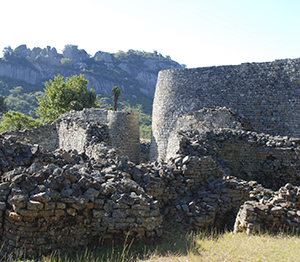 This morning we drive to the Great Zimbabwe Ruins located close to Masvingo. According to an age-old legend the ruins were built to replicate the palace of the Queen of Sheba in Jerusalem, and are a unique testimony to the Bantu civilization of the Shona between the 11th and 15th centuries. They cover an area of 1800 acres and are some of the oldest and largest structures located in Southern Africa. We have the opportunity to explore these ancient ruins, before checking in to our accommodation for the night. This morning we drive to the Great Zimbabwe Ruins located close to Masvingo. According to an age-old legend the ruins were built to replicate the palace of the Queen of Sheba in Jerusalem, and are a unique testimony to the Bantu civilization of the Shona between the 11th and 15th centuries. They cover an area of 1800 acres and are some of the oldest and largest structures located in Southern Africa. We have the opportunity to explore these ancient ruins, before checking in to our accommodation for the night.
|
Departure: 7am
Distance / Time: 355 kms
Overnight: Lodge of the Ancient City or similar (rooms with en-suite bathrooms, swimming pool, restaurant, & bar).
Meals: Breakfast at Camp Amalinda or similar, Lunch prepared by guide en-route, Dinner at Lodge of the Ancient City or similar. |
DAY 4;
(1 Night)
GREAT ZIMBABWE TO BUSHMAN ROCK, Zimbabwe [Chalets] |
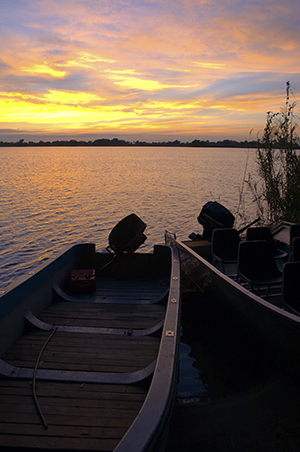 We travel towards Harare to the Bushman Rock Estate, operational since the mid 1900’s it is one of the few estate wineries in the country. After we have settled into our rooms, we have the option to walk to the Bushman Rock, where we can explore the ancient art adorned caves and granite kopjies. After the walk high tea is served on the veranda. In the late afternoon we take a leisurely guided walk through the vineyards to the pontoon, for a sundowner cruise. Thereafter we get to sample up to nine of the estates private wines on a tutored wine tasting, followed by 3 course dinner. We travel towards Harare to the Bushman Rock Estate, operational since the mid 1900’s it is one of the few estate wineries in the country. After we have settled into our rooms, we have the option to walk to the Bushman Rock, where we can explore the ancient art adorned caves and granite kopjies. After the walk high tea is served on the veranda. In the late afternoon we take a leisurely guided walk through the vineyards to the pontoon, for a sundowner cruise. Thereafter we get to sample up to nine of the estates private wines on a tutored wine tasting, followed by 3 course dinner.
|
Departure: 8am
Distance / Time: 365 kms
Overnight: Bushman Rock or similar (rooms with en-suite bathrooms, swimming pool and tea garden).
Meals: Breakfast at Lodge of the Ancient City or similar, Lunch prepared by te guide en-route, Dinner at Bushman Rock or similar. |
DAYS 5 - 6;
(2 Nights)
BUSHMAN ROCK TO MANA POOLS NATIONAL PARK, Zimbabwe [Tents] |
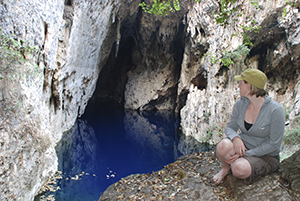 An early wake-up call to continue our journey to one of Zimbabwe’s greatest national parks – Mana Pools, where we have the whole of the next day available to search for African wildlife on game drives and on canoe excursions. Activities take place in small customised groups offering clients the best game viewing experience possible. Mana means ‘four’ in Shona, in reference to the four large permanent pools formed by the meandering Zambezi River. This World Heritage site has the country's biggest concentration of hippos and crocodiles as well as large populations of elephant and buffalo. En-route we stop at Chinhoyi Caves for lunch. The caves are composed of limestone and dolomite and it is the most extensive cave system in Zimbabwe accessible to tourists. An early wake-up call to continue our journey to one of Zimbabwe’s greatest national parks – Mana Pools, where we have the whole of the next day available to search for African wildlife on game drives and on canoe excursions. Activities take place in small customised groups offering clients the best game viewing experience possible. Mana means ‘four’ in Shona, in reference to the four large permanent pools formed by the meandering Zambezi River. This World Heritage site has the country's biggest concentration of hippos and crocodiles as well as large populations of elephant and buffalo. En-route we stop at Chinhoyi Caves for lunch. The caves are composed of limestone and dolomite and it is the most extensive cave system in Zimbabwe accessible to tourists.
|
Departure: 7am
Distance / Time: 385 kms
Overnight: Nyamepi Camp or similar (tents, communal ablutions with hot water).
Meals Day 5: Breakfast at Bushman Rock or similar, Lunch prepared by guide en-route, Dinner at Nyamepi Camp or similar.
Meals Day 6: Breakfast at Nyamepi Camp or similar, Lunch at Nyamepi Camp or similar, Dinner at Nyamepi Camp or similar.
|
DAYS 7 - 8; (2 Nights)
MANA POOLS TO LAKE KARIBA, Zimbabwe [Chalets] |
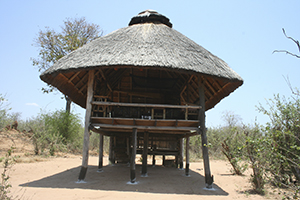 Our journey today brings us to the shores of Lake Kariba. It is one of the world’s largest man-made lakes and a place of outstanding beauty. At over 220 km long and 30 km at its widest point it is no wonder it is referred to as an inland sea! The lake is nested in mountains, guarded by enormous reserves of game and made beautiful and savage by sun and storm, as well as by earth and water. After lunch and a one and a half hour speedboat trip across the lake we arrive at Rhino Camp, which lies on Elephant Point in the Matusadona National Park, which is home to the Big 5 and where we spend the next two nights. Our journey today brings us to the shores of Lake Kariba. It is one of the world’s largest man-made lakes and a place of outstanding beauty. At over 220 km long and 30 km at its widest point it is no wonder it is referred to as an inland sea! The lake is nested in mountains, guarded by enormous reserves of game and made beautiful and savage by sun and storm, as well as by earth and water. After lunch and a one and a half hour speedboat trip across the lake we arrive at Rhino Camp, which lies on Elephant Point in the Matusadona National Park, which is home to the Big 5 and where we spend the next two nights.
|
Departure: 7am
Distance / Time: 170 kms
Overnight: Rhino Camp or similar (chalets with en-suite bathrooms, bar area).
Meals Day 7: Breakfast at Nyamepi Camp or similar, Lunch prepared by guide en-route, Dinner at Rhino Camp or similar.
Meals Day 8: Breakfast at Rhino Camp or similar, Lunch at Rhino Camp or similar, Dinner at Rhino Camp or similar. |
DAY 9; (1 Night)
LAKE KARIBA TO ANTELOPE PARK, Zimbabwe [Tented Camp] |
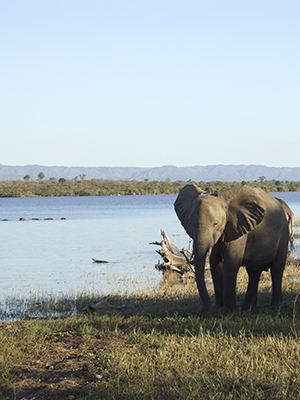 Today we have an early departure as it is one of the longest driving days on our safari. Another speedboat takes us back to Kariba where we meet our vehicle and continue to Antelope Park where we spend the night. Antelope Park is home to the African Lion Environmental Research Trust (ALERT), an organisation encouraging sustainable means to conserve lions. You will have the opportunity to partake in optional activities either in the late afternoon (subject to the time of arrival), or the next morning before departure. Today we have an early departure as it is one of the longest driving days on our safari. Another speedboat takes us back to Kariba where we meet our vehicle and continue to Antelope Park where we spend the night. Antelope Park is home to the African Lion Environmental Research Trust (ALERT), an organisation encouraging sustainable means to conserve lions. You will have the opportunity to partake in optional activities either in the late afternoon (subject to the time of arrival), or the next morning before departure.
|
Departure: 7am
Distance / Time: 525 kms
Overnight: Antelope Park or similar (river tent with en-suite bathrooms, swimming pool, bar and restaurant area).
Meals: Breakfast at Rhino Camp or similar, Lunch prepared by the guide en-route, Dinner at Antelope Park or similar. |
DAYS 10 - 11; (2 Nights)
ANTELOPE PARK TO HWANGE NATIONAL PARK, Zimbabwe [Chalets] |
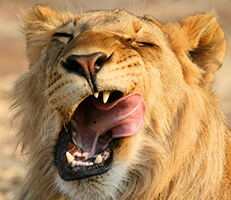 After breakfast we depart and make our way to Hwange National Park. Hwange is one of Africa's finest havens for wildlife in Zimbabwe and the park is home to vast herds of elephant, buffalo, and zebra as well as a very large concentration of giraffe. It also hosts many predators and endangered species plus very large and varied birdlife. The whole of the next day is spent exploring this magnificent area. After breakfast we depart and make our way to Hwange National Park. Hwange is one of Africa's finest havens for wildlife in Zimbabwe and the park is home to vast herds of elephant, buffalo, and zebra as well as a very large concentration of giraffe. It also hosts many predators and endangered species plus very large and varied birdlife. The whole of the next day is spent exploring this magnificent area.
|
Departure: 7am
Distance / Time: 440 kms
Overnight: Sable Sands or similar (chalets with en-suite bathroom, swimming pool & bar area).
Meals Day 10: Breakfast at Antelope Park or similar, Lunch prepared by the guide en-route, Dinner at Sable Sands or similar.
Meals Day 11: Breakfast at Sable Sands or similar, Lunch pack on game drive, Dinner at Sable Sands or similar.
|
DAY 12; (1 Night)
HWANGE TO VICTORIA FALLS, Zimbabwe [Chalets] |
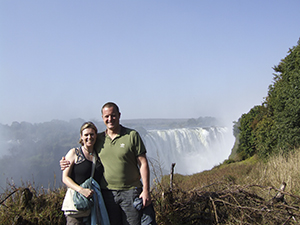 We visit the Painted Dogs Conservation Centre in Hwange, to learn about the efforts made to protect these endangered species, before heading off to Victoria Falls. On arrival, your guide will take you on a tour of the mighty Victoria Falls, known by the local Kololo tribe as Mosi oa Tunya - “the smoke that thunders”. The rest of the day may be spent at leisure or partaking in one of the many optional activities on offer. We visit the Painted Dogs Conservation Centre in Hwange, to learn about the efforts made to protect these endangered species, before heading off to Victoria Falls. On arrival, your guide will take you on a tour of the mighty Victoria Falls, known by the local Kololo tribe as Mosi oa Tunya - “the smoke that thunders”. The rest of the day may be spent at leisure or partaking in one of the many optional activities on offer.
|
Departure: 8am
Distance / Time: 190 kms
Overnight: A’Zambezi River Lodge or similar (rooms with en-suite bathrooms, swimming pool, bar & restaurant).
Meals: Breakfast at Sable Sands or similar, Lunch prepared by guide, Dinner for your own account.
|
DAY 13;
VICTORIA FALLS, Zimbabwe [TOUR ENDS] |
Our safari ends after breakfast. You will be transferred to Victoria Falls Airport in time for
your departure flight. We hope to welcome you again one day on another of our
African adventures. |
Meals: Breakfast at A'Zambezi River Lodge or similar. |
Note: The accommodation specified in the itinerary is a guide only and is subject to availability. Alternatives will be nearby and of a similar standard.
 Top Top
CLICK TO SEE DEPARTURE DATES
Included
Accommodation as mentioned in the itinerary, all transport in appropriate vehicle, game drives as mentioned, meals and activities as mentioned in itinerary, park entrance fees, experienced local guide.
Excluded
Travel insurance, flights, pre and post tour accommodation, optional activities, all drinks, tips and curios, all personal expenses.
Departure
The Intimate Zimbabwe Safari departs from Camp Amalinda or similar in Motobo Hills, Zimbabwe.
Please note that the daily departure times are a guideline only and are subject to
change due to seasonal variations, as well as unforeseen circumstances. The final
decision rests with your guide who will advise you at what time you will be departing
each day.
In the evening of day 1, there will be a meeting presented by your guide, at 18h00, at your lodge. It is imperative that all clients attend this meeting so as not to miss out on any critical information.
Whilst it is our every intention to adhere to the above mentioned itinerary, there may on occasion be a necessity to make alterations in order to make the tour more enjoyable or practical. Therefore please treat the itinerary as a guide only.
Transport
The tour uses fully-equipped Toyota Land Cruisers, 12-seater 4x4 safari vehicles or other appropriate vehicles with comfortable seating, large windows for game viewing, a music and PA system and air-conditioning. All luggage, besides hand luggage and photo equipment, is carried on the vehicle, trailer or roof racks to ensure maximum comfort in the vehicle. For transfers between Victoria Falls and Hwange (or vice versa), 2x4 vehicles may be utilised.
Travelling Times and Distances
All travelling times are affected by road conditions, border crossings, detours and weather conditions, therefore on certain days travelling times may be longer than anticipated especially where there is a lot of distance to be covered. Please keep in mind that the time it takes to travel 100 km in your home country is not equivalent to the time it takes to travel 100 km on African roads, therefore we encourage you to sit back
and enjoy the spectacular scenery Africa has to offer. Where possible additional stops
will be made to ensure your travelling comfort at all times.
Accommodation
On 10 nights of this safari, you will be accommodated in typical mid-range African lodge establishments, situated either in the National Parks, on the banks of a river, or other place of interest. Lodge Safaris offer accommodation with a mix of lodges, chalets and tented camps. All of them have a private bathroom with a shower or bath and a toilet. Some properties are equipped with swimming pools and/or bar areas. The remaining two nights of this safari will be in a basic tented camp with communal ablution facilities.
Local Payment
A local payment is required on your safari and will be collected by your guide on the day of departure. The local payment is part of the overall tour cost and is used to pay some of the day to day operational costs that are incurred while we are on the road. We try to prepay as many of the costs as possible however in some cases cash payment on arrival is the only option as some of the attractions we visit on safari only accept cash. Examples include park fees at most of the national parks, a few accommodations or camp sites and any local food markets we visit to stock up on fresh produce during the tour as well as local guides.
Your tour guide is given a garage card to pay for fuel, however this is only valid for use in South Africa and certain parts of Namibia therefore any other fuel purchases also need to be paid for in cash. The local payment also ensures that a portion of your tour cost actually goes directly to the countries you visit, thus benefiting local communities as well as contributing to conservation of the areas we visit. Essentially having a local payment means your tour price is a bit lower and gives you a more inclusive experience.
Visas
The onus is on the client to organize all visas required to visit Zimbabwe prior to departure.
Information on Areas Visited
ZIMBABWE
This is a country blessed with great natural beauty, game reserves and mineral wealth.
The diverse landscape changes from mountainous to wilderness to typical Bushveld. The
country is also home to large animals and a large bird population. Zimbabwe is a country
located in the southern part of the continent of Africa, between the Victoria Falls,Zambezi River, Kariba Dam and the Limpopo river. Zimbabwe is bordered by South Africa
to the south, Botswana to the west, Zambia to the north and Mozambique to the east.
Victoria Falls
'So lovely it must have been gazed upon by angels in their flight' said David Livingstone
of the supreme Mosi-oa-Tunya ('The smoke that thunders'). This legendary traveler first
saw the Falls from the Zambian side and his memory is enshrined in the nearby town of
Livingstone. The views from the Zimbabwean & Zambian side are quite different, varying
dramatically depending on the season and water flow.
The Falls are over a mile in length and boast the largest curtain of water in the world -
over 500 million litres of water per minute cascade over the falls and drop 100m at
Rainbow Falls on the Zambian side. Not surprisingly is it the seventh natural wonder of the
world and fast becoming one of the top adventure destinations in the world.
The river is divided into a series of braided channels that descend in many separate falls.
Below the Falls the river enters a narrow series of gorges, which represent locations
successively occupied by the falls earlier in their history. Since the uplifting of the
Makgadikgadi Pan area some two million years ago, the Zambezi River has been cutting
through the basalt base rock, exploiting weak fissures, and forming a series of retreating
gorges. Seven previous waterfalls occupied the seven gorges below the present falls,
and Devil's Cataract in Zimbabwe is where the next cut back will form a new waterfall
that will eventually leave the present falls lip high above the river in the gorge below.
Hwange National Park
Hwange National Park is one of Africa's finest havens for wildlife and is home to vast
herds of elephant, buffalo, and zebra and has a very large concentration of giraffe. It is
also home to many predators and endangered species plus very large and varied
birdlife.
The park is situated on the main road between Bulawayo and the world famous Victoria
Falls. Hwange National Park covers just over 14 600 square kilometres. The Park carries
105 mammal species, including 19 large herbivores and eight large carnivores. Elephant
make up the largest proportion of the biomass. All Zimbabwe's specially protected
animals are to be found in Hwange and it is the only protected area where gemsbok
and brown hyena occur in reasonable numbers. The population of wild dog to be found
in Hwange is thought to be of one of the largest surviving groups in Africa today.
The landscape includes desert sand to sparse woodland as well as grasslands and
granite outcrops. Due to the lack of water, man-made waterholes were introduced to
sustain the animals through the dry season. The park has an interesting variety of
landscapes with one part running alongside the North-eastern end of the Kalahari
Desert. The south is sandy with extensive forests and open grassland. A feature of the
area is ancient fossil dunes - ancient sand dunes held together by vegetation.
Matobo
The Matobo National Park forms the core of the Matobo or Matobo Hills, an area of
granite kopjes and wooded valleys commencing some 35 kilometres south of Bulawayo,
southern Zimbabwe. The Hills were formed over 2000 million years ago with granite being
forced to the surface, this has eroded to produce smooth "whaleback dwalas" and
broken kopjes, strewn with boulders and interspersed with thickets of vegetation. Mzilikazi,
founder of the Ndebele nation, gave the area its name, meaning 'Bald Heads'.
The Hills cover an area of about 3100 km², of which 424 km² is National Park, the
remainder being largely communal land and a small proportion of commercial
farmland. The park covers some beautiful scenery including some spectacular balancingrocks and impressive views along the Thuli, Mtshelele, Maleme and Mpopoma river
valleys. Part of the national park is set aside as a 100 km² game park, which has been
stocked with game including black and white rhinoceros. The highest point in the hills is
the promontory named Gulati (1549 m) just outside the north-eastern corner of the park.
Great Zimbabwe
Construction starting in the 11th century and continuing for over 300 years, the ruins at
Great Zimbabwe are some of the oldest and largest structures located in Southern
Africa. At its peak, estimates are that the ruins of Great Zimbabwe had as many as 18,000
inhabitants. The ruins that survive are built entirely of stone. The ruins span 1,800 acres
(7 km²) and cover a radius of 100 to 200 miles (160 to 320 km).
The ruins can be broken down into three distinct architectural groups. They are known as
the Hill Complex, the Valley Complex and the famous Great Enclosure. The Hill Complex
was used as a temple, the Valley complex was for the citizens, and the Great Enclosure
was used by the king. Over 300 structures have been found so far in the Great Enclosure.
The type of stone structures found on the site gives an indication of the status of the
citizenry. Structures that were more elaborate were probably built for the kings and
situated further away from the center of the city. It is thought that this was done in order
to escape sleeping sickness.
What little evidence exists suggests that Great Zimbabwe also became a center for
trading, with artifacts suggesting that the city formed part of a trade network extending
as far as China. Chinese pottery shards, coins from Arabia, glass beads and other nonlocal
items have been excavated at Zimbabwe.
Nobody knows for sure why the site was eventually abandoned. Perhaps it was due to
drought, perhaps due to disease or it simply could be that the decline in the gold trade
forced the people who inhabited Great Zimbabwe to look for greener pastures.
Nyanga National Park
Nyanga (formerly known as Inyanga) is a town in the province of Manicaland,
Zimbabwe, located adjacent to Nyanga National Park in the Eastern Highlands about
105 km north of Mutare. According to the 1982 Population Census, the town had a
population of 2,973. The highest mountain in Zimbabwe, Mount Nyangani lies about 15km from the village. Its highest peak rises to 2,600 m above sea level. Nyanga is a popular tourist destination with its trout fishing, golf courses, mountain hikes and holiday resorts.
Nyanga also accommodates the highest waterfalls in the country - the Mtarazi Falls are
about 760 m high. The surrounding areas also contain many Stone Age and Iron Age
archaeological remains such as pit structures, stone forts, terraces and pathways.
In the town is the bustling township of Nyamhuka, around which there is an ever
expanding growth of high and medium density housing.
The Nyanga Area has long been regarded as a place of great natural beauty. In 1896,
Cecil John Rhodes wrote to his agent: "Dear McDonald, Inyanga is much finer than you
described...Before it is all gone, buy me quickly up to 100 000 acres [400 km²], and be
sure to take in the Pungwe Falls. I would like to try sheep and apple growing."
Mana Pools
Mana Pools is a wildlife conservation area in Northern Zimbabwe constituting a National
Park. It is a region of the lower Zambezi River in Zimbabwe where the flood plain turns into
a broad expanse of lakes after each rainy season. As the lakes gradually dry up and
recede, the region attracts many large animals in search of water, making it one of
Africa's most renowned game-viewing regions.
Mana means 'four' in Shona, in reference to the four large permanent pools formed by
the meanderings of the middle Zambezi. These 2,500 square kilometres of river frontage,
islands, sandbanks and pools, flanked by forests of mahogany, wild figs, ebonies and
baobabs, is one of the least developed National Parks in Southern Africa. It was saved
from a hydro-electric scheme in the early eighties which would have seen the flooding of
this subsequent World Heritage site. It has the country's biggest concentration of
hippopotamuses and crocodiles and large dry season mammal populations of elephant
and buffalo.
Lake Kariba
Having cascaded over the Victoria Falls, and tumbled and swirled through the Batoka
gorges, the old Zambezi River then flowed gently across a flat valley floor to the Kariba
gorge. This was the home of the BaTonka people who believed there was a god of the
river – Nyaminyami. Enter technological man and his desire to put a dam wall across the
Kariba gorge to harness the river's flow to generate hydroelectric power. The dream
became a fact in December 1958, and the man-made Lake Kariba began to fill, and
reached its capacity four years later. In the meantime, about 57 000 tribes people had to
be resettled, and "Operation Noah" led by Rupert Fothergill, had rescued and
translocated 5000 animals.
Kariba dam wall has a height of 128 m and produces a lake of 5200 km² in area at full
capacity. Then the water surface is at an altitude of 484 m above sea level. On the
Zimbabwean side, the water became the Lake Kariba Recreational Park, with an area of
2830 km². During its life so far, the lake has had its share of ecological incidents, and three
should be mentioned. In its early eutrophic days, the lake witnessed an invasion of a
water fern (Salvinia molesta), named the Kariba weed, but over the ensuing years the
weed has greatly declined. In the 1960s several introductions of the Lake Tanganyika
sardine (Limnothrissa miodon) were made, and eventually the 'kapenta' fishery has
developed to great productivity. Finally, being a 'sink', the lake has accumulated
pesticides and pollution from agriculture and tsetse fly control in its catchment.
Fortunately, surveys have shown that the early dire predictions, for example, of Fish
Eagles going extinct, have not been realised.
Kariba town is one of the hottest places in Zimbabwe, with temperatures sometimes
exceeding 40ºC. The average rainfall along the lake is 650-700 mm, occurring mainly in
November to March. The main habitats are mopane woodland and grassland in the
shore, with shelving or rocky slopes. There are many islands (previously hill-tops) in the
lake. The Zambezi water is rather clean and poor in nutrients, having filtered through Barotseland in Zambia, which puts a severe limit on the numbers of water birds that can
be accommodated. Nevertheless along the shore one seems never to be out of earshot
of a vociferous Fish Eagle, and this bird can surely serve as the emblem for the lake.
 Top Top
Please contact us for dates.
 Top Top  Return to Budget Safari Packages Return to Budget Safari Packages
|